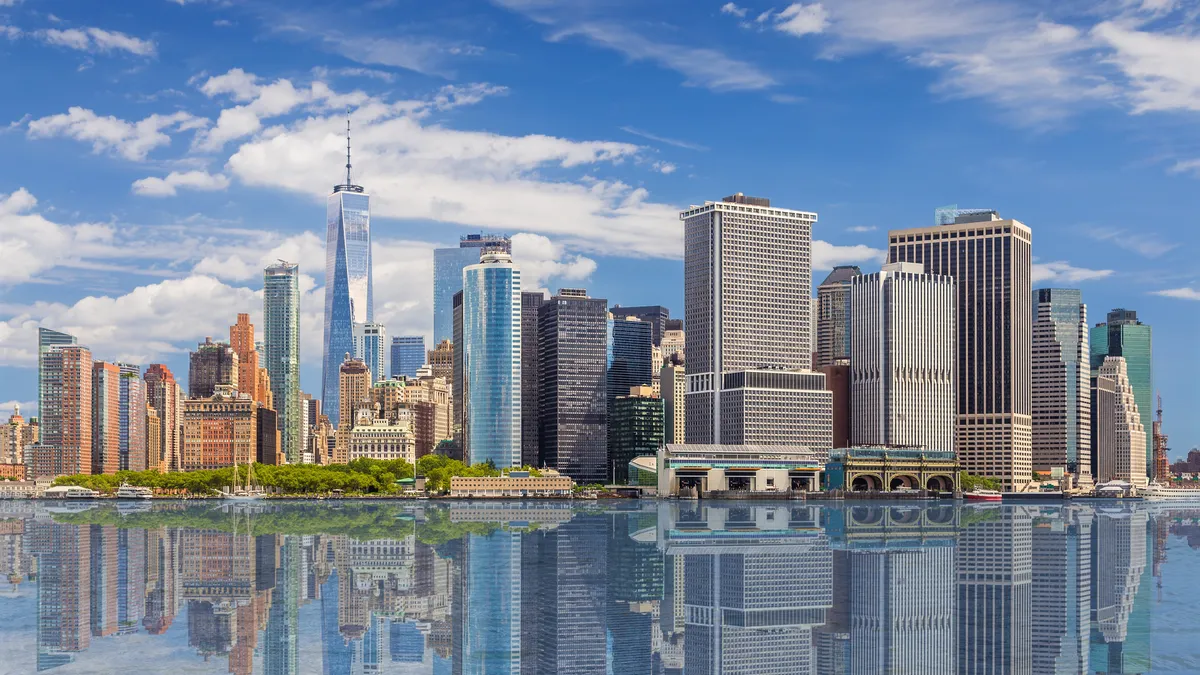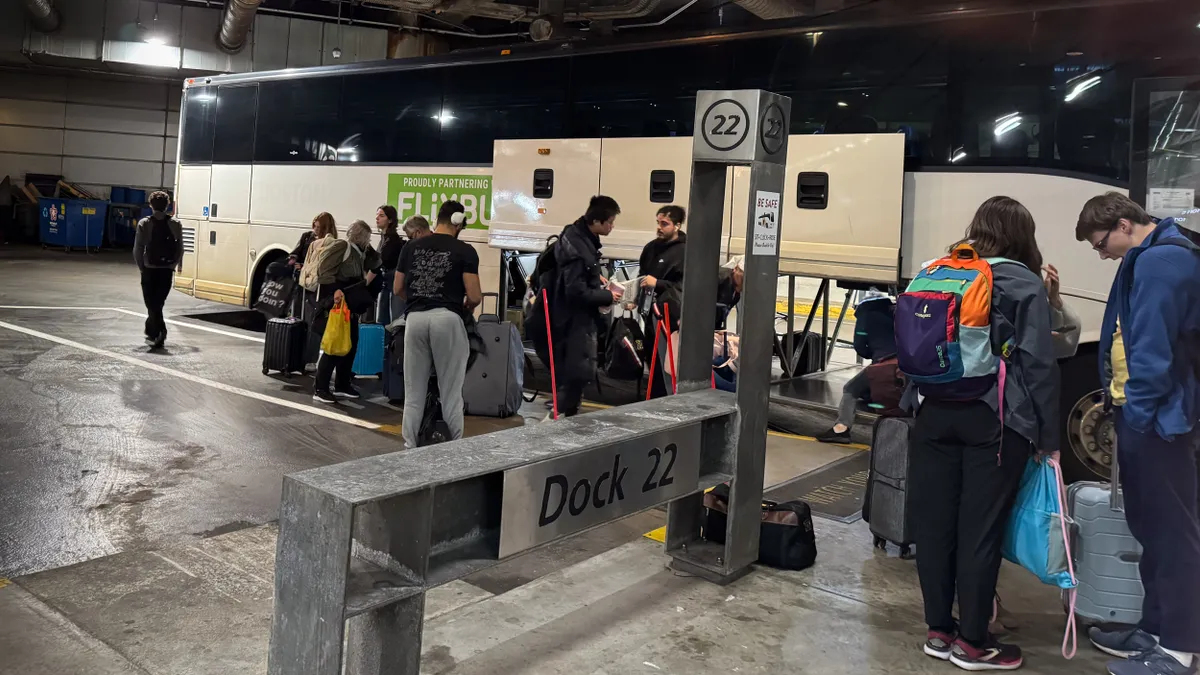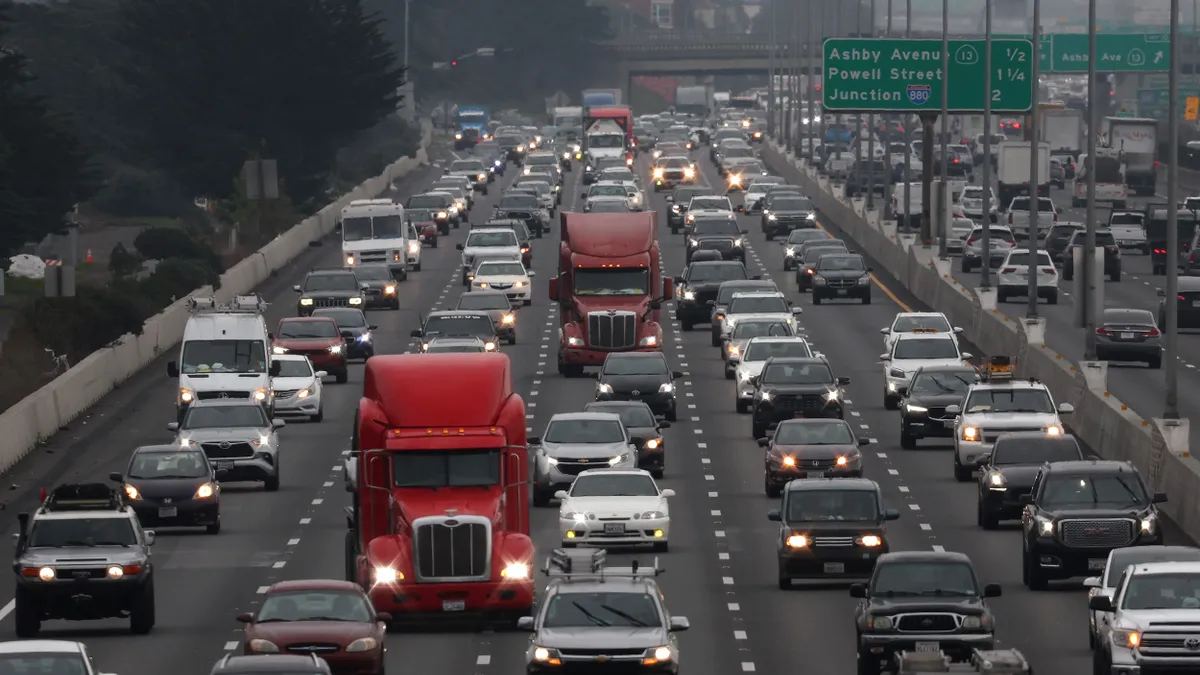Editor's note: This story is the first in a series on the trends that will shape smart cities in 2022.
Cities needed to adapt to tremendous challenges in 2021. Leaders faced increasingly dangerous driving behavior, extreme weather events, tense political climates and rising crime rates in addition to the ongoing, and constantly changing, COVID pandemic.
Despite the past year's many obstacles, some cities made progress in becoming more sustainable and equitable places to live by increasing investments in cycling and electric vehicle infrastructure, piloting free public transportation, and continuing to help close the digital divide. Moving into the new year, local leaders say they are likely to continue to focus on those initiatives, as well as on cybersecurity, infrastructure and climate resiliency.
Smart Cities Dive asked readers to share how they think cities will evolve in 2022. Here's a selection of responses we received:
The following responses have been edited for clarity and length.
Data and technology will help close the digital divide
"In 2022, we anticipate cities — now more tech-savvy than ever — will have an increased focus on using technology to improve equity for city residents, with a particular emphasis on bridging the digital divide that separates Americans with access to high-speed internet from those without.
We expect that data teams who’ve focused on outreach efforts to assist residents in understanding the benefits of wearing masks and getting vaccinated will leverage the lessons they have learned to create new outreach efforts to expand broadband access, broadband subsidies for low-income users, online literacy programs, and other digital equity efforts.
These teams will leverage both first-party city data sources, open [government] data sources (like FCC data), data modeling and open-source technology to identify digital divide access and outreach via maps and dashboards. Importantly, they'll rely more than ever on technology to show progress against these equity initiatives.”
— Clare Epstein, vice president of public sector at Civis Analytics
♦♦♦
Cities will need to improve efficiencies at the curb
"Even as we return to life outside of our homes, it's clear that online shopping behaviors and demands for at-home delivery are here to stay. Cities will need to implement the technologies and policies that mitigate the congestion and pollution challenges spurred by increased commercial vehicle activity—or risk falling behind. From [New York City] to Omaha, we're beginning to see cities of all sizes explore curb management solutions that will only grow in popularity throughout 2022."
— Jordan Justus, CEO of Automotus
♦♦♦
Cities will make more bold climate commitments
"Cities are going to increasingly be at the forefront of driving the fight against climate change, with more bold commitments like [that from] the commitment from the city of Ithaca, New York, to decarbonize 100% of its buildings by 2030. To achieve these ambitious and essential goals will require the end of piecemeal actions and a move towards integrated and packaged solution sets with built-in financing."
— Kate Frucher, managing director at The Clean Fight
♦♦♦
The circular economy will take hold in transportation
“Right now, entrepreneurs are at the forefront of creating a circular economy, with new technologies that reduce packaging and textile waste ... In 2022, our cities will start to see those circular economy methods transferred to the linear transportation industry. This means we’ll see circular design and production through modular design and the use of low-carbon circular materials, circular use through the increased utilization of vehicles, specifically EVs, and circular retirement with a shift from maintenance and planned obsolescence to collection, remanufacturing, and recycling.”
— Micah Kotch, managing director at URBAN-X
♦♦♦
Cybersecurity defenses will need to grow
"From ransomware attacks on school systems and hospitals to threats on critical infrastructure, state and local IT leaders are under immense pressure to build strong cyber defenses against bad actors. Organizations should focus on data protection, including backing up systems routinely, reinforcing basic cybersecurity awareness and education, and revisiting cyber incident response plans often."
— Mike Wiseman, vice president of public sector at Pure Storage
♦♦♦
Ransomware attacks will increase
"In 2021 we saw that ransomware can be both wildly successful and devastating (i.e., the attacks on Colonial Pipeline and Kaseya), in part because adversaries found a way to be highly efficient in their attacks – they can keep costs low and take advantage of a repeatable operating model. Because this model has become so effective, malicious actors will only accelerate their focus on ransomware in 2022.
Part of the reason why ransomware attacks have been so pervasive is because of the ability to exchange large sums of money without traceability. Until we eliminate or regulate the cryptocurrency economy, we will keep seeing the rise of ransomware into 2022 and beyond.”
— Andrew Rubin, CEO of Illumio
♦♦♦
Technology advances will foster stronger trust and civic participation
"Smart city technologies deployed in communities did not traditionally result in more connected communities, where the beneficiaries of these advances [understand and trust those technologies], due to a fracture between IoT deployment and public participation and feedback into that process.
The pandemic, however, directly resulted in rapid modernization in customer experience for public services. The ecosystem is now enabled with new solutions like omnichannel communications and enhanced data insights that before were unattainable. As a result, we are going to finally see smart city technologies that deploy with next-generation, 311-style services built with newly trusted and compliant citizen engagement technologies that empower communities to understand and shape development from the start, rather than feel imposed upon by sensors that the community doesn’t always understand and can’t always see the value in."
— Justin Herman, global head of public sector at Twilio
♦♦♦
Cities will upgrade infrastructure to be more resilient
"As cities begin to recover from the pandemic, increased focus will be placed on preparation for natural disasters, climate events and other issues by investing in technology that makes cities run more efficiently and seamlessly, no matter the situation. Cities need to make sure citizens have access to services [that could range] from alternative energy sources to community-based Wi-Fi programs."
— Matthew Britt, general manager of smart cities & communities at Honeywell Building Technologies
♦♦♦
E-bikes and shared mobility will continue to advance
"I predict the continued rise of the connected e-bike, which will create pressure to build out safe infrastructure. Improved and cheaper battery tech and small electric motors will also create new form factors in the (very) lightweight electric vehicle space. We will see better quantification of shared mobility's carbon reduction, impacting policies and infrastructure investments. We might start seeing web3 tech deployed in shared mobility systems."
— Benjie de la Peña, CEO of the Shared-Use Mobility Center
♦♦♦
EV charging infrastructure will grow and build resilience
"As more consumers adopt electric vehicles, we will see a move away from charging at home, as most people do not live somewhere they can charge. There will be more emphasis on ubiquitous public charging locations where people are already going, like the office, retail spaces, the park, etc.
The impacts of electricity grid failures stemming from natural disasters and extreme weather will also become recognized as a significant vulnerability. So, more emphasis will be placed upon off-grid, locally generated and stored electricity, particularly for EV charging. Additionally, grid capacity will be recognized as a choke point that will largely be solved by smaller microgrids and other off-grid solutions."
— Desmond Wheatley, CEO of Beam Global
♦♦♦
Wireless power will become prevalent
"Integrating wireless power into buildings and infrastructures will not only allow for reduced wiring and maintenance costs but will also enable consumers to power their smart homes and personal gadgets. IoT sensors in these devices could track important data such as air quality, temperature, consumption of resources, health and activities around the city, allowing for streamlined analysis and improvements to be made sooner.
Smart cities have the ability to use data and technology to transform municipalities into efficient, productive and environmentally sustainable hubs. Establishing smart cities with wireless power will reduce battery and electronic waste by increasing product lifetimes, making harmful batteries obsolete and enabling a more sustainable power source."
— Hatem Zeine, founder and president and CTO of Ossia and creator of Cota Real Wireless Power
♦♦♦
Libraries should be a central resource hub
"[In 2022,] public libraries should be the hub for rebuilding communities (and maybe a return to civic/civil discourse), workforce development, entrepreneurship, and positive social change and advancement. Libraries are the best place for free and open access for everyone to books, resources, programming, bridging the digital divide, raising knowledge, and fact-checking — library workers are better than the Internet for that."
— Adam Zand, president and co-founder of The Library Land Project
♦♦♦




















